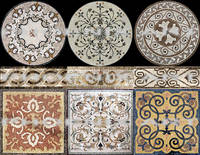

Although the underdog, Entellus became so angry with Dares that he had to be stopped from killing him. In the boxing match between the Trojan, Dares, against Entellus, a Sicilian, Entellus won the match. This scene is from Book V of Virgil’s Aeneid which refers to the Trojan hero, Aeneas, hosting funeral games in Sicily to commemorate the passing of his father. In the scene, one is bleeding from the head and the bull in the background is also bleeding.

Ancient Roman athletes often competed in the nude. Mosaic floor with a Boxing Scene or mosaic floor with Combat Between Dares and Entellus depicts two men wearing nothing but their boxing gloves. They narrated the tales using key elements like objects, characters, or symbols that were familiar to the viewers. Roman artists used mosaics to tell a story. Roman floor mosaics: Mosaic with a Boxing Scene, 175 CE, stone and glass tesserae, The J. The ancient floor mosaics were largely made of stone tesserae, in the Tethys mosaic both stone and glass pieces are used especially for the marine creatures. Although the sea creatures around Tethys are not entirely of a naturalistic depiction, they have been identified as dolphins, squid, goatfish, sea bream, and percoid fish (such as bass).

The sea goddess Tethys was not an unusual subject for Antioch since the city was located on several bodies of water, and visual art from the area often included marine themes. The Tethys mosaic was originally located in a pool in a bath building. The mosaic was excavated in 1939 by a team of archeologists from Harvard University, the Worcester Art Museum, Princeton University, and the Baltimore Museum of Art. At its center is the bust of the goddess, Tethys, surrounded by 23 sea creatures of different shapes and colors. The mosaic comes from the ancient Roman city of Antioch, present-day Turkey. The floor mosaic of the Sea Goddess Tethys is currently located on the university campus of Harvard Business School. Roman floor mosaics: Mosaic of the Sea Goddess Tethys, mid-4th century CE, Harvard Business School, Boston, MA, USA. Perhaps, the mosaic adorned the floor of a room for entertaining guests. In the mosaic, there is no reference to Orpheus’s music, but the visitors were familiar with the mythological figure. His music was appreciated by everyone, including the gods, animals, and trees. He learned to play the lyre from Apollo, the sun god. Orpheus was a musician, poet, and prophet in Greek mythology. The mosaic was discovered in 1912 in Saint-Romain-en-Gal, France, and originally decorated a room of approximately 15 feet by 20 feet. On the four corners are figures, each representing the Four Seasons: Spring, Summer, Autumn, and Winter. The hexagon contains the bust of Orpheus wearing a Phrygian cap, surrounded by six animal figures. The central panel or emblema of the Orpheus and the Animals floor mosaic comprises of a hexagon with a border of double-strand guilloche circles. Roman floor mosaics: Orpheus and the Animals, mosaic floor central panel, 150–200 CE, stone and glass, The J.

Even though, the Romans used the Gorgon image for decorative purposes, she continued to be regarded as a protective symbol. The Gorgon’s head was a popular apotropaic device in Greek art, supposedly used to ward off evil influences or bad luck. She was beheaded by Perseus who presented her head to his patron goddess Athena, daughter of Zeus. In Greek mythology, Medusa was a fearsome monster who could turn onlookers into stone. The design is inspired by Athena’s aegis, the scaly protective cloak decorated with Medusa’s decapitated head. The head of Medusa on a shield motif appeared frequently on Roman mosaic floors. The guilloche pattern or braided pattern border the circle and the inner part of the square. The circle is enclosed in an outer square with kantharoi or drinking cups at the corners. In this mosaic, Medusa is portrayed in a shield of concentric black and white triangles which create an optical illusion of continuous motion. Medusa’s snake-like hair was replaced with wild curls and she was represented like the Hellenistic Kings and Alexander the Great, with her wind-blown hair and turned head. The Greek representation of Medusa as a monster had been replaced with a more human-like figure by the Romans around 100 CE. At the center of this mosaic floor is the bust of the gorgon, Medusa. Mosaic floor with Head of Medusa was discovered on the floor of a Roman villa in 1910 in Rome. Roman floor mosaics: Mosaic with Head of Medusa, ca.


 0 kommentar(er)
0 kommentar(er)
